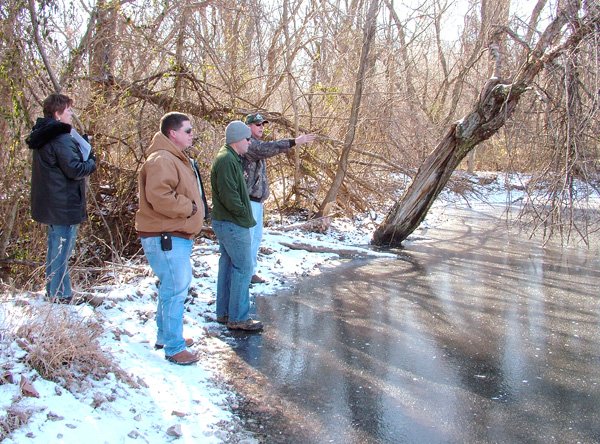GENTRY — Ponds at the proposed site of a new Gentry park may not be deep enough to sustain game fish, according to visiting biologists from the Arkansas Game and Fish Commission.
Ron Moore, AGFC district fisheries biologist, and John Stein, AGFC fish management biologist, visited the site of city-owned land along Flint Creek near Arkansas Highway 59 on Thursday with Gentry Chamber of Commerce director Bev Saunders, city councilman Jason Barrett and landscape architect Matt Parks. The purpose of the visit was to determine whether or not the ponds on the city-owned property could be stocked and used for public fishing.
The two ponds - the result of beaver dams - are spring fed from springs, just north of Dawn Hill East Road, with one pond feeding into the other. Though the ponds are small area-wise, the biggest concern was the shallow depth of the ponds.
“We like to see a depth of atleast 8 feet,” Moore said, and the ponds appeared to be far more shallow than that even at their deepest points, though iced-over portions made it somewhat difficult to gauge.
The possibility of dredging the ponds to make them deeper was discussed, but Moore suggested consulting someone familiar with building ponds in the area first. He suggested an engineer and the county conservation agent as sources of valuable information.
“If you dredge, it (the pond) could leak,” Moore said, explaining that the rocky subsoil conditions make the area prone to leaking ponds.
“Ponds typically seep at first, and then, when the silt builds up, they seal,” Moore said, adding as an aside that an old-time cure for leaking and seeping ponds was tolet hogs wallow in them.
The possibility of stocking trout was discussed since the ponds are spring fed and spring water is typically 58-59 degrees, according to Moore. That would be cold enough for trout, but Moore said the temperature would have to be monitored closely duringthe summer months by taking afternoon readings every day. Trout wouldn’t survive if water temperatures remained above 70 degrees for extended periods of time, Moore said.
Seasonal stocking of the ponds could also be an option, according to Moore. He spoke of seasonal stocking of trout or stocking the ponds with catfish for local fishing derbies, saying it was “a great thing” to get kids outside and fishing but that it also takes a lot of sponsors and volunteers to make the derbies work.
Moore said he doubted the park idea would fall within the scope of Arkansas Sport Fishing Restoration Grants but suspected other grants might be available to the city to help with the project.
“I admire what you’re trying to do here,” Moore said. “This would make a very nice community park, but there’s a lot of work to be done first."
Most of the area is overgrown with vines and briars and is littered with fallen trees.
Moore said the city should also be aware that at least a portion of the area was in a flood plain, which could result in the need to clean up the park after heavy rains and rebuild portions of walks and trails - especially near the creek.
He suggested consulting Dave Evans, the regional stream coordinator, for guidance on plans along Flint Creek itself.
“If you can make this into a park, have public access for fishing and get enough depth in the ponds, we’ll stock fish,” Moore said.
The city is exploring the possibility of cleaning up its property along Flint Creek to turn it into a park where people could enjoy the natural setting of the creek and possibly fish in the ponds there. Also discussed as part of longer-range plans is connecting walking trails from the Highway 59 sidewalks and then east along Dawnhill East Road and back to the schools along Pioneer Lane.
News, Pages 1 on 01/19/2011

